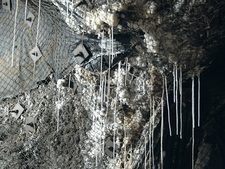Konrad is not comparable with Asse
As to a report stating that allegedly more water flows into Konrad than it does into Asse, the Federal Office for Radiation Protection gives the following statement:

![]() A wet place underground. The deep water originates from the time many million years ago when the geological layers deposited
A wet place underground. The deep water originates from the time many million years ago when the geological layers deposited
As is usual in mines, there is also sea water in the Konrad mine, having been isolated when the rock formed. Right from the start, however, this has been the objective of safety assessments and the licensing documents relating to the Konrad mine and is thus no news. A comparison with the situation in the Asse mine is not correct.
The situation in Asse
In the Asse mine, an unlimited volume of water flows into the mine from outside. Salt having been produced here commercially up to the very margin, the rock presses upon the salt dome from outside. Thus, cracks form through which water flows in. In the course of time, these cracks become larger and larger. In such mines, this may lead to an uncontrolled inflow of water. Besides, the Asse mine is a salt mine which is soluble in water, as opposed to Konrad (an iron ore mine).
The situation in Konrad
As in every other mine, there are limited volumes of entrapped sea water in the Konrad mine, on the other hand, which originated when the rock formed; there is also water flowing in via the open shafts. The entrapped water has existed for millions of years and are not in contact with the biosphere. The shafts will be sealed after emplacement, so that no more water can flow into the mine.
This issue is known and has repeatedly been communicated by the BfS, e.g. in the internet (Hydrogeology, Formationwater in Konrad) and in brochures.
Among others, the water in Konrad is used for watering the walls and roads, as the mine is very dry and dust formation due to work processes is reduced.
State of 2012.06.15

